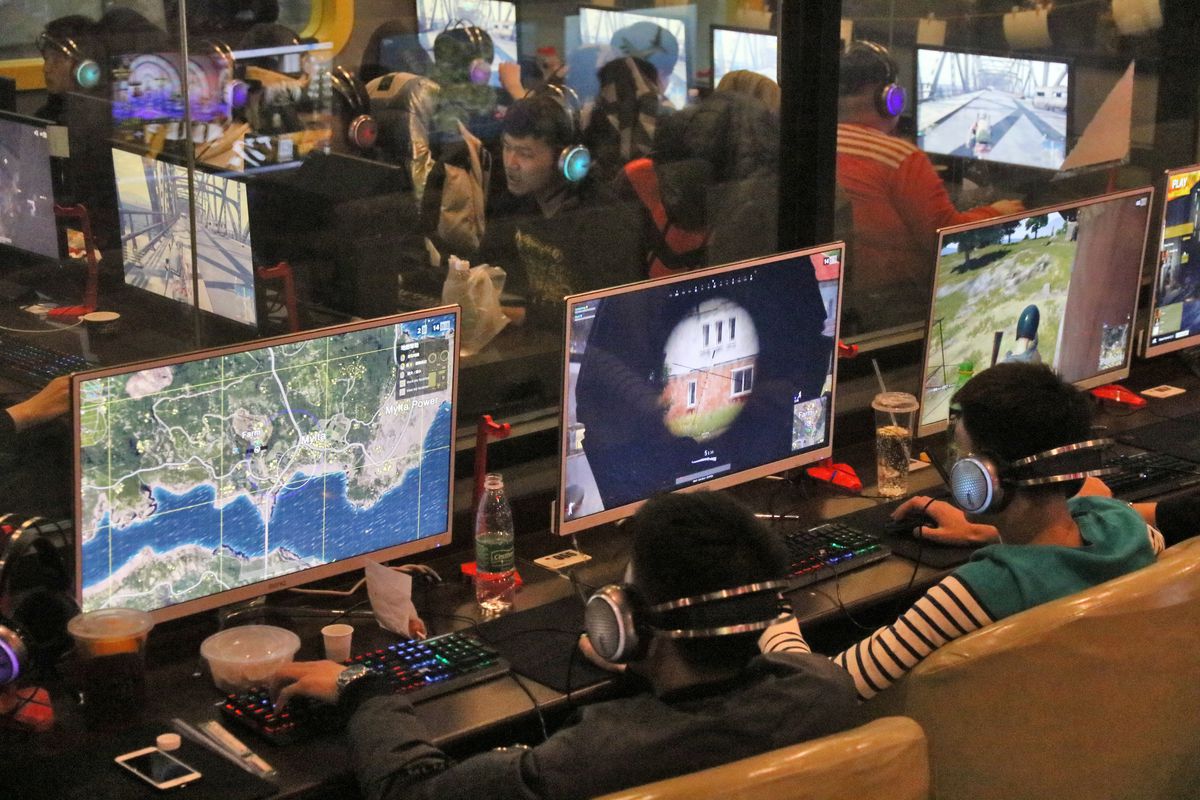Introduction
Online gaming has become a popular form of entertainment for millions of people around the world. Whether it’s battling opponents in a virtual realm or joining forces with friends to conquer a challenging quest, online games offer endless opportunities for excitement and camaraderie.
Behind the scenes of these immersive gaming experiences are complex systems that enable players to connect and interact in real-time. At the heart of this infrastructure are online gaming servers. These servers play a crucial role in facilitating gameplay, ensuring smooth communication between players, and providing a seamless gaming experience.
In this article, we will explore what online gaming servers are, their importance in the gaming ecosystem, and how they work. We will also discuss the various types of gaming servers, the communication between game clients and servers, server maintenance and optimization, the significance of server location, and the security measures taken to protect player data.
By gaining a deeper understanding of online gaming servers, players can better appreciate the complexity that goes into creating and maintaining their favorite online games. So, let’s dive into the fascinating world of online gaming servers and discover the intricacies that power our favorite digital adventures.
What is an online gaming server?
An online gaming server is a powerful computer or network of computers that acts as a central hub for online games. It serves as the backbone of multiplayer gaming, allowing players from different locations to connect, interact, and engage in gameplay together in real-time.
Think of an online gaming server as a virtual playground where players gather to participate in the game. The server acts as a mediator, facilitating communication and coordination between players, handling gameplay mechanics, and storing vital information such as player profiles, game progress, and in-game assets.
Online gaming servers are typically equipped with high-performance hardware and advanced networking capabilities to handle the demands of multiple players simultaneously. They are designed to minimize latency, ensuring that interactions between players happen quickly and smoothly without any noticeable delays.
Furthermore, online gaming servers employ software that manages and regulates the gameplay experience. This software monitors player actions, enforces game rules, and synchronizes the game state across all connected clients. It also handles tasks such as matchmaking, session management, and data synchronization to provide a seamless multiplayer experience.
Without online gaming servers, multiplayer gaming as we know it would not be possible. These servers enable players to connect and compete or collaborate with others, fostering a dynamic and interactive gaming environment. Whether it’s teaming up with friends in a cooperative game or engaging in intense player versus player battles, online gaming servers are the backbone that holds the entire experience together.
In the next section, we will delve deeper into the role of online gaming servers and discuss why they are essential for seamless multiplayer gameplay.
The role of online gaming servers
Online gaming servers play a crucial role in the world of multiplayer gaming. They serve as the backbone of the gaming experience, providing essential functions that ensure smooth gameplay and seamless interactions between players. Let’s explore the key roles performed by online gaming servers:
- Player Connection: The primary role of an online gaming server is to facilitate player connections. When players launch a game and connect to a server, they establish a virtual link to other players in the game. The server acts as a central hub, allowing players to join matches, create parties, and communicate with one another. Without servers, players would be isolated, unable to connect with other gamers in real-time.
- Game Logic and Mechanics: Online gaming servers handle the complex game logic and mechanics that govern the gameplay experience. They ensure that the rules of the game are enforced consistently, whether it’s calculating damage in a combat scenario or resolving in-game events. The server synchronizes the game state across all connected clients, ensuring that every player experiences the same events and outcomes.
- Storage and Persistence: Online gaming servers store vital information such as player profiles, achievements, in-game currency, and inventory. This information is preserved even when players disconnect from the game. Servers ensure the persistence of progress, allowing players to resume their gaming sessions and retain their progress across multiple play sessions.
- Matchmaking and Session Management: Servers play a vital role in matchmaking, grouping players with similar skill levels or preferences to ensure balanced and enjoyable matches. They also manage game sessions, handling tasks such as starting, pausing, and ending matches. Servers keep track of player statistics, providing rewards and rankings based on performance.
- Communication and Interaction: Online gaming servers enable players to communicate and interact with each other in various ways. They facilitate voice and text chat features, allowing players to strategize, coordinate, and socialize during gameplay. Servers also enable in-game features such as trading, gifting, and forming guilds or clans, fostering a sense of community among players.
Overall, online gaming servers are the backbone of multiplayer gaming, providing the necessary infrastructure and functionalities that enable players to connect, compete, and collaborate in a shared virtual environment. Without these servers, the vibrant and dynamic world of online gaming as we know it today would not be possible.
How do online gaming servers work?
Online gaming servers employ a complex system of hardware and software to ensure seamless gameplay and real-time interaction between players. Let’s take a closer look at how these servers work:
1. Client-Server Architecture: Online gaming servers utilize a client-server architecture, where the client is the player’s game client (the software running on their device), and the server is the central hub that manages and coordinates the gameplay experience. The client sends requests to the server, such as movements, actions, and chat messages, while the server processes these actions and relays the necessary information back to the client and other players.
2. Network Communication: Online gaming servers rely on efficient networking to handle real-time communication between players. When a player’s client sends a request to the server, it travels across the internet, reaching the server’s network infrastructure. The server processes the request and sends the appropriate response back to the player’s client, enabling them to see the result of their actions in the game.
3. Game State Synchronization: To ensure that all players in a multiplayer game experience the same gameplay events, online gaming servers rely on game state synchronization. The server constantly updates the game state based on the actions and inputs received from all connected clients. It then sends these updates to each client, ensuring that everyone sees a consistent and synchronized game world.
4. Load Balancing and Scaling: Online gaming servers handle a massive influx of players simultaneously. To manage this load and maintain stable performance, servers employ load balancing techniques. Load balancing distributes player connections and game instances across multiple servers, ensuring that no single server becomes overwhelmed. Additionally, online gaming servers can scale up or down based on player demand, dynamically allocating resources to provide a smooth gameplay experience.
5. Database Management: Online gaming servers rely on databases to store and retrieve essential game-related data, such as player profiles, in-game assets, and progress. Servers utilize database management systems to efficiently handle data storage, retrieval, and updates, ensuring that player information remains secure and accessible.
6. Server-Client Communication Protocols: To facilitate fast and reliable communication between the server and clients, online gaming servers use specialized communication protocols. These protocols optimize the transmission of data, minimizing latency and ensuring that game-related information is delivered swiftly between the server and clients.
Through this intricate combination of network communication, game state synchronization, load balancing, database management, and communication protocols, online gaming servers provide a seamless and immersive multiplayer gaming experience.
The different types of online gaming servers
Online gaming servers come in various types, each designed to cater to specific gameplay requirements and genres. Here are some of the most common types of online gaming servers:
- Dedicated Servers: Dedicated servers are standalone servers dedicated solely to hosting a specific game or a cluster of games. These servers provide robust performance and customization options, allowing game developers to have full control over the server environment. Dedicated servers are commonly used for massively multiplayer online games (MMOs) and large-scale multiplayer experiences.
- Peer-to-Peer Servers: In a peer-to-peer (P2P) server setup, players connect directly with each other rather than through a central server. This type of server is often used in games with smaller player counts or in situations where real-time communication and coordination are not critical. P2P servers are commonly found in smaller multiplayer games or games where players can host their own servers.
- Cloud-based Servers: Cloud-based servers leverage cloud computing infrastructure to host online games. These servers offer scalability, flexibility, and high availability, allowing game developers to easily manage player demand and provide consistent performance across different regions. Cloud-based servers are increasingly popular, as they can handle large player bases and provide global reach.
- Modded Servers: Modded servers are customized game servers that allow players to modify or add custom content to the game. These servers can host modified game versions with additional features, gameplay mechanics, or user-created content. Modded servers provide players with unique gameplay experiences and foster thriving modding communities.
- Virtual Private Servers (VPS): VPS servers are virtual servers hosted on a physical server, but each VPS operates independently with its own operating system and dedicated resources. VPS servers offer a balance between performance and cost, making them a popular choice for smaller game servers or community-hosted servers.
The choice of online gaming server type depends on various factors, including the game’s requirements, player count, budget, and desired level of control. Game developers and server administrators carefully consider these factors to select the server type that best suits their game’s needs.
It’s worth noting that these server types can sometimes overlap or be combined, depending on the specific requirements of the game. For example, a game might utilize cloud-based servers for global availability and scalability but also incorporate dedicated servers for specific game modes or regions.
Understanding the different types of online gaming servers helps players and developers navigate the vast landscape of multiplayer gaming, ensuring that they choose servers that offer the best performance, reliability, and gameplay experiences.
Game client-server communication
In the world of online gaming, seamless communication between the game client and the server is essential for a smooth and enjoyable gameplay experience. Let’s dive into how game client-server communication works:
1. Client Requests: The game client, running on the player’s device, sends requests to the server. These requests could include actions such as moving, attacking, or interacting with the game world. The client forms the request and sends it over the internet to the server, usually using a specific network protocol.
2. Server Processing: Upon receiving a request from a client, the server processes the request and performs the necessary calculations or checks based on the game’s logic and rules. This could include verifying the validity of the action, handling collisions, updating the game state, and executing any necessary game mechanics.
3. Game State Update: After processing the client’s request, the server updates the game state to reflect the changes. This updated game state includes the positions of players and other entities, environmental changes, and any other updates relevant to the current gameplay session.
4. Broadcast Updates: The server then broadcasts these updates to all connected clients, ensuring that everyone is on the same page and experiences a synchronized game world. This broadcast might involve sending the updated game state, event notifications, or other important information.
5. Client Receiving Updates: Each client receives the updates from the server and applies them to its local game instance. This allows players on different devices to see and interact with the same game world, ensuring consistency across all connected clients.
6. Visual Feedback: After applying the updates received from the server, the client renders the game visuals and provides visual feedback to the player on their device. This feedback includes the updated positions of characters and objects, animations, and any other visual effects associated with the requested action.
7. Latency and Lag: Latency, or the delay between a client’s action and the server’s response, can impact the gameplay experience. Players may perceive lag if there is a significant delay in receiving updates from the server. Game developers and server administrators strive to minimize latency through efficient server infrastructure, optimized networking protocols, and server locations that are close to players to reduce network travel time.
Effective client-server communication is crucial in online gaming, ensuring fair gameplay, synchronicity, and a consistent player experience. By maintaining a reliable and efficient flow of information between the client and the server, multiplayer games can offer seamless interactions that make players feel connected and immersed in the virtual worlds they inhabit.
Server maintenance and optimization
Server maintenance and optimization are vital aspects of ensuring the smooth operation and performance of online gaming servers. Let’s explore the significance of server maintenance and the various optimization techniques used:
Server Maintenance: Regular server maintenance is crucial for keeping online gaming servers running smoothly. This involves tasks such as applying software patches and updates, monitoring server health and performance, and addressing any potential issues or vulnerabilities. Server maintenance also includes routine backups to prevent data loss and the implementation of security measures to safeguard player information.
Optimizing Server Performance: To provide an optimal gaming experience, online gaming servers employ various optimization techniques:
- Hardware Upgrades: Upgrading server hardware, including processors, memory, and storage, can significantly enhance server performance and capacity. This ensures that the server can handle higher player loads, reduce latency, and deliver a smoother gameplay experience.
- Networking Optimization: Optimizing the server’s network infrastructure helps reduce latency and ensure a stable connection. This can include using high-speed internet connections, implementing load balancing techniques, and strategically locating servers in data centers or regions where players are concentrated.
- Code Optimization: Optimizing the server’s code improves its efficiency and responsiveness. This can involve optimizing algorithms, reducing unnecessary computations, and improving memory management. Code optimization helps reduce server resource usage, allowing more players to be simultaneously connected and improving overall server performance.
- Database Optimization: Optimizing the server’s database management system helps improve data retrieval and update speeds. Techniques such as indexing, caching, and database structure optimization enhance the server’s ability to handle large volumes of data and minimize database-related bottlenecks.
- Performance Monitoring: Regularly monitoring server performance is essential for identifying and resolving potential issues. Performance monitoring tools provide insights into resource utilization, network latency, and overall server health. By monitoring server performance, administrators can proactively address any bottlenecks or inefficiencies.
Scalability and Flexibility: Online gaming servers need to be designed with scalability and flexibility in mind. As player bases grow or fluctuate, servers should be capable of dynamically allocating resources to accommodate the changing demands. This scalability ensures that server performance remains stable, even during peak player activity.
Server Uptime and Availability: Ensuring high server uptime and availability is crucial for providing an uninterrupted gaming experience. Implementing redundant server setups, backup power systems, and network redundancy minimizes downtime due to hardware failures, power outages, or network disruptions.
By prioritizing server maintenance and implementing optimization techniques, online gaming servers can deliver consistent and satisfying gameplay experiences for players. Server administrators and developers continually work to improve server performance and reliability, allowing players to immerse themselves fully in the dynamic worlds of online gaming.
The importance of server location
The location of online gaming servers plays a significant role in determining the quality of gameplay and overall player experience. Let’s explore the importance of server location and its impact on online gaming:
Reduced Latency: Latency, or the delay between a player’s action and the server’s response, directly affects gameplay responsiveness. Servers located closer to players can significantly reduce latency, ensuring that actions feel more immediate and fluid. By minimizing latency, players can enjoy a more immersive gaming experience without noticeable delays between their actions and the server’s feedback.
Improved Network Connectivity: Server location also impacts network connectivity. By placing servers in well-connected data centers or regions with robust internet infrastructure, players can benefit from stable and fast network connections. This helps prevent connectivity issues, such as packet loss, lag spikes, and disconnections, which can disrupt gameplay and negatively impact the overall gaming experience.
Regional Player Base: The location of servers should align with the location of the player base. Placing servers closer to regions with a high concentration of players reduces the physical distance and network hops required for data to travel, further reducing latency. It also helps minimize potential disparities in connection quality between players in different regions, ensuring a level playing field for all participants.
Compliance with Data Regulations: Server location can also have legal implications related to data protection and privacy regulations. Different countries have varying laws regarding the storage and protection of user data. Game developers and server administrators must comply with these regulations by hosting servers in locations that align with the applicable data protection laws of the player base.
Accessibility and Regional Content: Server location can impact access to regional content or specific game features. For example, some games offer region-specific events, game modes, or localized content. Placing servers in those regions ensures that players can take full advantage of such features and enjoy a more tailored gaming experience.
Support for International Community: Games with an international player base can benefit from strategic server locations that cater to players from different regions. By having servers in multiple locations, game developers can provide localized gaming experiences, reduce latency for players across the globe, and promote social interaction among international communities of players.
Incorporating the importance of server location into the planning and deployment of online gaming servers is crucial for optimizing player experience. It requires careful consideration of factors such as network infrastructure, player distribution, data regulations, and regional content to provide an enjoyable and inclusive online gaming environment.
Security in online gaming servers
Ensuring the security of online gaming servers is of utmost importance to protect player data, maintain fair gameplay, and safeguard the integrity of the gaming experience. Let’s explore the various security measures implemented in online gaming servers:
Encryption: Online gaming servers utilize encryption protocols to secure the transmission of data between the game client and the server. This ensures that sensitive information, such as login credentials, payment details, and personal data, is protected from unauthorized access or interception.
User Authentication: Robust user authentication mechanisms are implemented to verify the identities of players before granting access to the server. This prevents unauthorized individuals from connecting to the server and participating in gameplay. Authentication methods may include passwords, biometrics, two-factor authentication, or integration with third-party login providers.
Data Protection: Online gaming servers employ measures to protect player data stored on the server. This includes implementing secure database management systems, regularly backing up data, and utilizing encryption for stored data. By applying strict access controls and authorization mechanisms, server administrators ensure that only authorized personnel can access or modify player data.
Anti-Cheating Measures: To maintain fair gameplay, online gaming servers employ anti-cheat mechanisms to detect and prevent cheating or hacking. These measures include detecting unauthorized modifications to game files, continuously monitoring player behavior for suspicious activities, and implementing algorithms to identify and penalize cheaters.
Server Monitoring: Continuous monitoring of online gaming servers helps identify any potential security vulnerabilities or performance issues. This monitoring involves tracking server activity, analyzing logs, and employing intrusion detection systems to detect and mitigate any malicious activities or hacking attempts.
Regular Updates and Patches: Game developers and server administrators regularly release updates and patches to address security vulnerabilities and fix bugs. Players are encouraged to keep their game clients up to date to ensure they benefit from the latest security enhancements and gameplay improvements.
Security Audits and Penetration Testing: Online gaming servers may undergo periodic security audits and penetration testing to assess their vulnerability to attacks. This proactive approach helps identify and address any potential security weaknesses before they can be exploited by malicious actors.
Player Reporting and Moderation: Online gaming servers often have reporting features and moderation systems in place to allow players to report suspicious or inappropriate behavior. Server administrators can then investigate such reports and take appropriate actions, such as banning or suspending offending players.
By implementing stringent security measures, online gaming servers can foster a safe and trustworthy environment for players. It is essential for game developers and server administrators to stay vigilant and proactive in their approach to ensure the security and integrity of the gaming experience.
Conclusion
Online gaming servers are the backbone of multiplayer gaming, providing the infrastructure necessary for players to connect, interact, and immerse themselves in virtual worlds. These servers facilitate real-time communication, handle game mechanics, synchronize game states, and store vital player data. Understanding how online gaming servers work and their critical roles in multiplayer gameplay is essential for both players and developers.
We explored the different types of online gaming servers, including dedicated servers, peer-to-peer servers, cloud-based servers, modded servers, and virtual private servers. Each type serves specific purposes and caters to different gameplay requirements.
The importance of server location in online gaming cannot be overstated. Placing servers strategically to reduce latency and ensure stable network connections is crucial for delivering a seamless and responsive gaming experience. Compliance with data regulations, accessibility to regional content, and support for international communities are additional factors to consider when determining server locations.
Maintaining and optimizing online gaming servers is vital to ensure stable performance and provide an enjoyable gaming experience. Server maintenance involves regular updates, monitoring server health, and implementing security measures to protect player data. Optimizing server performance includes hardware upgrades, networking optimization, code optimization, and database management optimization.
Security in online gaming servers is of utmost importance. Encryption, user authentication, data protection, anti-cheating measures, server monitoring, regular updates and patches, security audits, and player reporting systems all contribute to maintaining a secure gaming environment.
In conclusion, online gaming servers are the hidden heroes that make multiplayer gaming possible. By fostering seamless communication, providing stable connections, and implementing robust security measures, these servers enable players to embark on thrilling adventures and create memorable gaming experiences together.
























